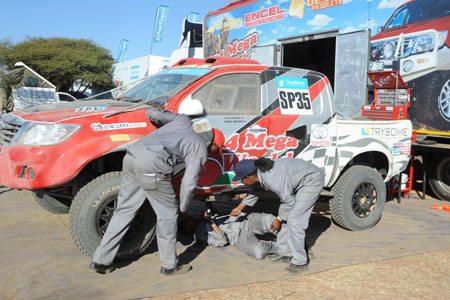Duo cherishes desert race experience
17 Jul 2013
What perhaps started as a dream drew closer to reality when an opportunity to work with racing teams at the just ended Toyota 1000 Kalahari Desert Race presented itself.
Ms Oratile Piet and Ms Kopo Monkge, both 26-years old and are mechanical engineering students became overjoyed when they got a slot to be attached in different car pits during Africa second most popular off road race as part of the behind the scenes’ technical crews.
“In the past we have seen these cars racing from far afield but now I get to work with them, It’s just unbelievable,” explained Ms Monkge beaming with excitement. Obviously the news was so exciting given what experience could do to their future careers.
It however did not eliminate the nerves factor. For starters, as students the stage was just too high for them. The idea of working with highly skilled personnel on an international platform was mindboggling.
However, the thought of dirtying their hands alongside the who’s who of the auto mechanics industry could not be traded for anything. On day one, Ms Monkge was at pains battling to believe that she was actually handling an SP34 Toyota Hilux, one of the favoured brand in the off road carnival.
What impressed her mostly was the level of science implored in the arrangement of the engine. “When I opened the bonnet, I was quite astonished after I realised that this was a moving machine with so many pipes,” she explained.
“Unlike your normal car, the fuel tank is at the back and it has many springs to cushion it when moving in the uneven course.” The technical crew, she said, was comprised of about six to seven people working as a team although division of labour was a virtue.
“When the car gets in, it is suspended and immediately the engine is inspected. Leakages on the pipes are checked then the nuts and bolts are fastened. The gear box is also checked. Similarly the team checks if the lights are working properly. Then they clean the wind screen and both mirrors.”
Ms Piet explained that while they did that, they gave the drivers water, fsnack and an energy drink, even some sweets. Two bottles of water, she said, were also put in the car for both the driver and the navigator. In a final check, tyres were checked for cracks then the car was fuelled.
“On day two, I rushed to clean the windscreen,” remarked Ms Monkge as she was now fully aware of what they were supposed to do.
For the outspoken Ms Piet, what impressed her was how the team worked together like pieces of a puzzle to put everything together under less than 15 minutes. She also observed that technical know-how and pace were the determinant factors to work in the team because everyone worked under pressure.
“You have to be fast and know what you are doing,” said Ms Piet. Even the type of tools used by technical crews is out of this world. “Instead of using your normal wheel spanner, they use an impact tool to fasten and loosen the bolts.”
Conversely she explained that it was great working with the experienced guys who were very helpful and patient. That is how they managed to fit in the team and remain comfortable. The two dream of one day owning their garage.
Ms Monkge and Ms Piet were the only two females out of the 15 mechanical engineering students from Botswana College of Engineering and Technology (BCET) engaged at the desert race at the behest of the chairman of 4 Wheel Drive Club Mr Alan Reid. Ends
Source : BOPA
Author : Lindi Morwaeng
Location : Molepolole
Event : interview
Date : 17 Jul 2013






